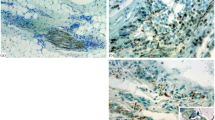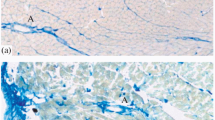Abstract
Effects of phosphocreatine on the neurohumoral mechanisms controlling the heart under conditions of a local immune injury were studied in acute experiments on anesthetized dogs using electrophysiological, biochemical, and electron microscopy techniques. After the development of heart injury, cardiogenic depressor reflexes evoked by an intracoronary injection of veratrine and mediated by vagus mechanisms disappeared, while pressor reflexes became dominating. This phenomenon correlated with an increase in concentration of a vasoconstrictor agent, leucotriene LTC4, in the blood and with a considerable ultrastructural impairment of nerve terminals in the myocardium. Preliminary injection of phosphocreatine prevented the development of structural impairments, favored the preservation of vagosympathetic depressor reflex, and not only prevented the increase in LTC4 concentration, but even dramatically decreased its level (by 82%, as compared with the initial level). We concluded that complex protective effect of phosphocreatine provides structural and functional preservation of the receptor apparatus in the heart and can play a considerable role in normalization of neurohumoral mechanisms controlling the heart under conditions of pathological impairment.
Similar content being viewed by others
References
R. Hainsworth, “Reflexes from the heart,”Physiol. Rev., 21, No. 3, 617–649 (1991).
M. L. Semenovskii (Semenovsky), V. I. Shumakov, V. G. Sharov, et al., “Protection of ischemic myocardium by exogenous phosphocreatine,”J. Thorac. Cardiovascul. Surg., No. 5, 762–769 (1987).
P. J. Hearse, D. A. Stewart, and M. V. Brainbridge, “Cellular protection during myocardial ischemia,”Circulation, 54, No. 1, 193–202 (1976).
V. G. Sharov, N. J. Afonskaya, M. Y. Ruda, et al., “Protection of ischemic myocardium by exogenous phosphocreatine (neoton): pharmacokinetics of phosphocreatine, reduction of infarct size, stabilization of sarcolemma of ischemic cardiomyocytes and antithrombotic action,”Biochem. Med. Metabol. Biol., 35, No. 1, 101–114 (1986).
A. A. Molbenko, G. I. Marchenko, L. F. Popovich, and G. A. Cherednichenko, “Mechanisms of protective effect of Neotone following immune injury of the heart,”Patol. Fiziol. Eksp. Ter., No. 2, 30–33 (1992).
A. A. Moibenko, G. I. Marchenko, V. N. Kotsyuruba (Kotsuruba), et al., “Effect of exogenous phosphocreatine on endotelium and endotelium-dependent vascular reactions in immune cardiac injury,”Current Ther. Res., 52, No. 6, 791–801 (1992).
Yu. P. Limanskii (Limansky), Z. A. Tamarova, A. I. Pilyavskii (Piliyavsky), et al., “The effect of phosphocreatine on reflex transmission in spinal cordin vivo andin vitro,” in:Cardioprotection with Phosphocreatine in Cardiology and Cardiosurgery, L. Trohconi and V. Sacs (eds.), Pavia (1989), pp. 105–120.
V. A. Sacs, S. A. Javadov, E. Posine, et al.,Creatine Phosphate, V. Sacs et al. (eds.), Torino (1987).
L. F. Popovich, V. F. Sagach, and V. G. Sharov, “An electron microscopic study of disturbances in the membrane permeability of cardiomyocytes following immune injury of the heart,”Byull. Eksp. Biol. Med., No. 11, 101–102 (1982).
V. B. Pavlyuchenko A. A. Molbenko, and L. V. Tumanovskaya, “Cardiogenic reflexes after immune injury of the heart”,Neirofiziologiya/Neurophysiology, 27, No. 1, 18–25 (1995).
A. A. Moibenko, G. M. Butenko, and M. M. Povzhitkov,Cytotoxic Impairments of the Heart and a Cardiogenic Shock [in Russian], Naukova Dumka, Klev (1977).
L. V. Rosenstrauch and V. A. Sacs, “The antiarhythmic action of phosphocreatine in acute myocardial ischemia,”Biochem. Med., No. 1, 120–123 (1985).
S. P. Revel and V. S. Karnovsky, “Hexagonal assay of subunits in intercellular junctions of the mouse heart and liver,”J. Cell Biol., 33, 7–12 (1967).
A. A. Moibenko,Cardiogenic Reflexes and Their Role in the Circulation Control [in Russian], Naukova Dumka, Klev (1979).
A. A. Moibenko, L. F. Popovich, and V. F. Sagach, “Immune injury to heart muscle,”Sov. Med. Rev. Cardiol, No. 3, 169–202 (1989).
A. A. Moibenko and V. F. Sagach,Immunogenic Disturbances in the Functions of the Cardiovascular System [in Russian], Naukova Dumka, Kiev (1992).
G. Johnson, III, L. Furlan, N. Aokl, and A. Lefer, “Endotelium and myocardial protecting actions of taprostene, a stable prostacyclin analogue, after acute myocardial ischemia and reperfusion in cats,”Circ. Res., 66, No. 4, 1362–1370 (1990).
H. Araki and A. Lefer, “Role of prostacyclin in the preservation of ischemic myocardial tissue in the perfused cat heart,”Circ. Res., 47, No. 2, 757–764 (1980).
Author information
Authors and Affiliations
Additional information
Neirofiziologiya/Neurophysiology, Vol. 27, No. 2, pp. 140–146, March–April, 1995.
Rights and permissions
About this article
Cite this article
Pavlyuchenko, V.B., Popovich, L.F., Kotsyuruba, V.N. et al. Effects of phosphocreatine on the heart nerve structures under conditions of local immune impairment (electrophysiological and neurochemical aspects). Neurophysiology 27, 110–114 (1995). https://doi.org/10.1007/BF01305381
Received:
Issue Date:
DOI: https://doi.org/10.1007/BF01305381




